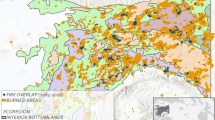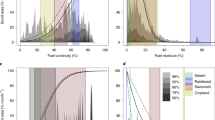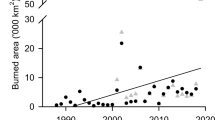Abstract
Of all the impacts of projected climate change on forest ecosystems, perhaps the most difficult to forecast is the potential for altered fire frequency and intensity. Fire regimes in forests are poorly understood for lack of long-term evidence. Here I used petrographic thin sections to determine the annual production of charcoal within a lake catchment in northwestern Minnesota over the past 750 years providing the long and high-resolution record required to elucidate fire regimes. Maximum abundance and frequency occurred in the warm, dry fifteenth and sixteenth centuries. Fire importance decreased dramatically with the onset or intensification of the 'little ice age' about AD 1600. Fire cycles with harmonics corresponding to multiples of the 22-year drought cycles of the region and increased fire frequency at times when early successional stands were breaking up, suggest a synergistic influence of climate and fuel accumulation. The anomalously warm, dry twentieth-century climate would have produced substantially different fire regimes from the previous century in the absence of fire suppression.
This is a preview of subscription content, access via your institution
Access options
Subscribe to this journal
Receive 51 print issues and online access
$199.00 per year
only $3.90 per issue
Buy this article
- Purchase on Springer Link
- Instant access to full article PDF
Prices may be subject to local taxes which are calculated during checkout
Similar content being viewed by others
References
Frissell, S. S. Quat. Res. 3, 397–407 (1973).
Leonard, E. M. Quat. Res. 25, 199–214 (1986).
E. C. Grimm New Phytol. 93, 311–350 (1983).
Borchert, J. R. A. Ann. Am. Geogr. 61, 1–22 (1971).
Mitchell, J. M., Stockton, C. W. & Meko, D. M. in Solar-Terrestrial Influences on Weather and Climate (eds McCormac, B. M. & Seliga, T. A.) 125–143 (Reidel, Dordrecht, 1979).
Clark, J. S. Quat. Res. 30, 81–91 (1988).
Clark, J. S. Quat. Res. 30, 67–80 (1988).
Clark, J. S. Ecol. Monogr. (in the press).
Heinseiman, M. L. Quat. Res. 3, 329–382 (1973).
Haines, D. A., Main, W. A. & McNamara, E. F. USDA For. Serv. Res. Pap. NC-158 (1978).
Chandler, C., Cheney, P., Thomas, P., Trabaud, L. & Williams, D. Fire in Forestry I: Forest Fire Behavior and Effects (Wiley, New York, 1983).
Gore, J. A. & Patterson, W. A. Can. J. For. Res. 16, 335–339 (1986).
Harmon, M. E. et al. Adv. Ecol. Res. 15, 133–302 (1986).
Heinseiman, M. L. in Fire Regimes and Ecosystem Properties (eds Mooney, H. A., Bonnicksen, T. M., Christensen, N. L., Lotan, J. E. & Reiners, W. A.) 7–57 (USDA For. Serv. Gen. Tech. Rep. GTR-WO-26, Washington DC, 1981).
Olsen, J. S. in Fire Regimes and Ecosystem Properties (eds Mooney, H. A., Bonnicksen, T. M., Christensen, N. L., Lotan, J. E. & Reiners, W. A.) 327–378 (USDA For. Serv. Gen. Tech. Rep. GTR-WO-26, Washington DC, 1981).
Meentenmeyer, V. Ecology 59, 465–472 (1978).
Author information
Authors and Affiliations
Rights and permissions
About this article
Cite this article
Clark, J. Effect of climate change on fire regimes in northwestern Minnesota. Nature 334, 233–235 (1988). https://doi.org/10.1038/334233a0
Received:
Accepted:
Issue Date:
DOI: https://doi.org/10.1038/334233a0
This article is cited by
-
Prediction of forest fire occurrence in China under climate change scenarios
Journal of Forestry Research (2023)
-
The value of linking paleoecological and neoecological perspectives to understand spatially-explicit ecosystem resilience
Landscape Ecology (2019)
-
Dryness thresholds for fire occurrence vary by forest type along an aridity gradient: evidence from Southern Australia
Landscape Ecology (2018)
-
Predicting Fire Frequency with Chemistry and Climate
Ecosystems (2012)
-
Spatiotemporal Variations of Fire Frequency in Central Boreal Forest
Ecosystems (2010)
Comments
By submitting a comment you agree to abide by our Terms and Community Guidelines. If you find something abusive or that does not comply with our terms or guidelines please flag it as inappropriate.



